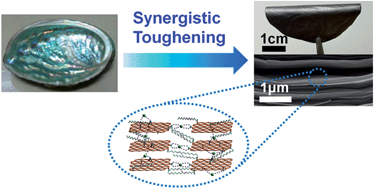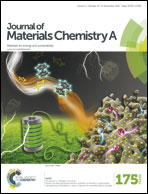Robust bioinspired graphene-based nanocomposites via synergistic toughening of zinc ions and covalent bonding†
Abstract
Robust graphene-based nanocomposites show promising applications in fields of flexible, wearable and intelligent devices. But, it is still a big challenge to construct high performance macroscopic graphene-based nanocomposites for practical application through cost-efficient graphene oxide (GO) nanosheets. Inspired by the hierarchical layered structure and interfacial interactions of nacre, we demonstrated robust graphene-based nanocomposites via synergistic interfacial interactions, which are constructed via divalent ions of zinc (Zn2+), and linear molecules of 10,12-pentacosadiyn-1-ol (PCDO) with GO nanosheets. The synergistic interfacial interactions result in integrated high strength, toughness and fatigue life. Furthermore, the resultant bioinspired graphene-based nanocomposites (BGBNs) also possess high electrical conductivity. The extraordinary performance allows this kind of BGBN to be potentially utilized in aerospace, flexible electrodes of supercapacitors and other intelligent devices. The demonstration of synergistic interfacial interactions of ionic and covalent bonding also supplies an effective approach for building robust graphene-based nanocomposites in the future.


 Please wait while we load your content...
Please wait while we load your content...